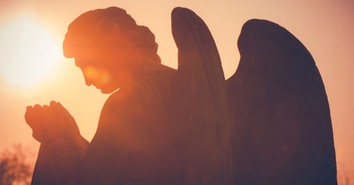Worship Dance Sets Prayers in Motion

Leaping in graceful unison across the stage, the dancers waved long purple ribbons in wide arcs over their heads. They danced together jubilantly in their shining white outfits until the song's pulsating rhythm ended. Then they clasped each other's hands and bowed their heads to the sound of enthusiastic applause.
But the applause wasn't for the dancers, because this wasn't just a recital. It was a worship dance offering, meant to celebrate Jesus. And after those onstage had danced for Him, the retirement home residents in the audience applauded for Him, moved by what they had just witnessed.
Worship dance, which expresses faith in tangible ways through its symbolic movements choreographed to worship music, is a beautiful and powerful way to praise God and communicate the gospel message to others, said worship dance company director Jeannine Lacquement.
"Because worship dance is nonverbal and creative, it reaches a person's imagination. Just as Jesus spoke into people's imaginations when He told stories, worship dance reaches beyond people's heads and into their hearts as it tells God's story," said Lacquement, who has led worship dance classes for children, teens and adults for many years in the Washington, D.C. area.
Although Psalm 149:3 proclaims, "'Let them praise His name with dancing ...', many Christians aren't familiar with worship dance," said Ann Thompson, who took one of Lacquement's classes for adult women. "I love Christian music and I love to dance, and I had never seen the two put together while I was growing up," she said. The mother of four said she was thrilled to discover how worship dance deepened her prayer life despite her hectic schedule. "If I've had a day where I've felt hassled and rushed and had my quiet time squeezed out, worship dancing helps me focus on God and draw closer to Him. The process of coming up with creative movements to express my worship to God has really stretched me. And, lots of times, the words of the songs will resonate in my head for a long time afterward."
Connecting With God
Worship dance is more about connecting with God from the heart than it is about following a stylized routine, said Lacquement. It can incorporate technical elements of art forms such as modern dance, jazz, pantomime and sign language. But, ultimately, "Worship dance is any movement that expresses honor and devotion to God," she said. "If we ever use our bodies at all to pray to God or to sing to God, that's a worship dance. Movement is a very basic, natural, God-given form of expression. And worship dance is something that all God's people can do."
Often, worship dancers will move in ways that symbolize a particular faith concept. For example, they can express humility or awe by bowing, then standing, or by lying prostrate on the floor. They can show a community of love by forming a circle in their dance. Or, they can illustrate a way God relates to His people.
"The movement of someone running toward you and embracing you represents God running toward us, accepting and loving us," said Lacquement. "If you couldn't speak with words, but you wanted to communicate a meaning, you could do it through worship dance.
"Worship dancers do their best to avoid any types of movement that could be considered provocative," Lacquement added, "And they're also careful to be modest and wear costumes that don't show the body's form." Above all, she said, "Worship dancers desire not that they be seen, but that God be seen, and that the people who see Him want to worship Him themselves."
Lacquement has taken worship dancers to a wide variety of places to perform - from shopping malls and parades to summer camps and retirement homes. They've even reached out to the Jewish community through a performance of their worship dance musical Moses and the Burning Bush at a Jewish community center.
But no matter where they perform, the dancers pray that their offering will draw audiences closer to Christ. Lacquement recalled a time when a man who had watched the dancers perform on the steps of the Lincoln Memorial in Washington, D.C. came up to them afterward. "He said, 'You know, I've just moved here and I've been feeling very lonely. But your presence has told me that I'm not alone. I know now that God is with me here.'"
Worship dancer Brian Colligan, 16, said he was struck by an audience's responsiveness after they watched a performance of Moses and the Burning Bush. "We were able to go out into the audience and talk with people, and they were like, 'That really touched me,' and 'Can you pray for me?' and even 'How can I get involved?' So you can really make an impact with worship dance," he said.
Worship dance can be just as effective at discipling the dancers as evangelizing audiences. It can be used for an outreach performance, but it can also be a way for people to express their own private devotions to God.
"Worship dance takes many forms - from an individual in a prayer closet, to someone expressing praise in the back row of a church worship service, to people dancing on the street or on a stage to honor God," said Lacquement. She and her students frequently discuss what the music's lyrics mean and go to the Bible to look up more about each song's message. "I really want the dancers to understand the words and meditate on them and let them become a part of them," she said.
Colligan said worship dance has affected all areas of his spiritual life. "It's helped me worship in other ways, too," he said. "It really frees you up to worship however you like, whenever and wherever you are, because you learn that you don't need to be self-conscious."
Sharon Lee, 10, also enjoys the freedom she's found through worship dance. "It's a lot of fun, and I think I've gotten closer to God through it," she said. "I always practice so hard and try to concentrate on the movements, but when I'm actually performing a dance, I feel free."
Lacquement, who suffers from fibromyalgia, said she doesn't feel pain while she's dancing, but she does sense God's presence and receive His grace. "I love the communion I experience with God when I'm dancing, and I love to see what He creates through me," she said.
Originally published September 16, 2004.







